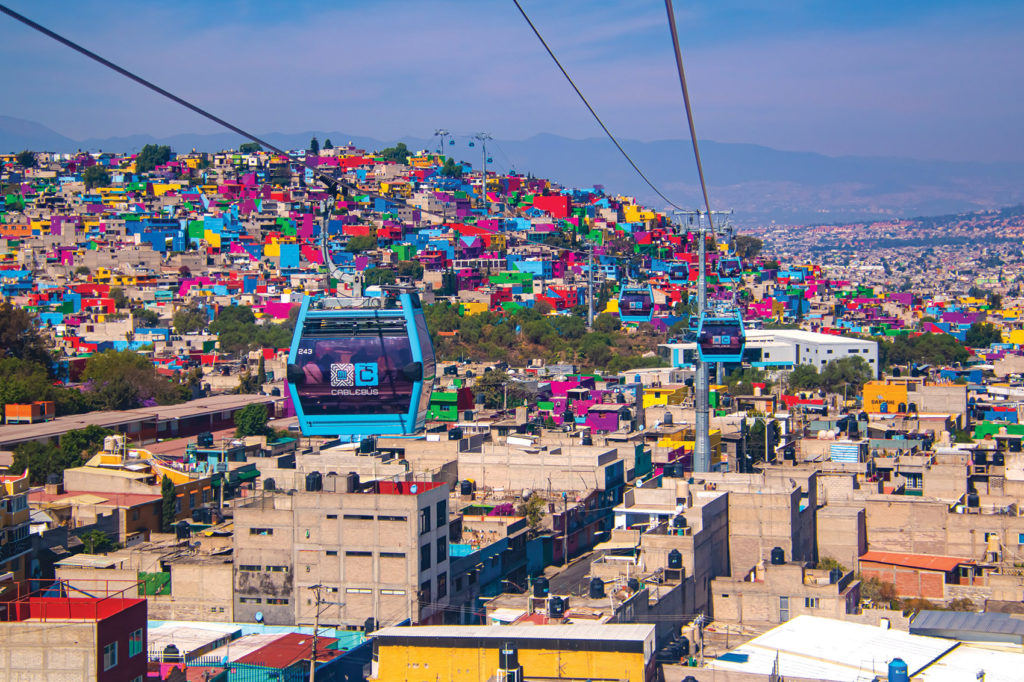Cable Cars as Feasible Urban Transport Option?
March 21, 2023

With the inauguration of its new 10.6-kilometre cable car route in August 2021, the government of Mexico City hoped to lift the spirits of residents in the large peripheral municipality of Iztapalapa by cutting commute times and exposing them to murals custom-made to be only visible from the sky.
The electric-powered cable cars, also known as gondolas, were also intended as a cleaner transportation option, placing less pressure on the environment than cars on the roads of one of the biggest cities in the world, which has also been among the most polluted in recent history. Similar goals have been pursued via cable cars in other cities of Latin America such as Medellín, Colombia1 and La Paz, Bolivia. They also make up public transport options in American, African and European cities.2
In Southeast Asia where urban transit is also an important challenge, cable car systems are more commonly used for tourism.
Indeed, thousands of miles away from Mexico City, the cable cars of Hon Tre Island in Vietnam3 began a nationwide craze in 2007 when they were constructed to feed the booming tourism industry and are now replicated all over the country. The cable cars have driven considerable economic development in Vietnam, but some have started to question whether there is an environmental cost.
Between Mexico City’s gondolas and Hon Tre Island’s cable cars, could they be a feasible urban transport option to alleviate the common issues that these two places—and others like them in Latin America and Southeast Asia—face?
El Cablebús


Line 2 of the Mexico City cable car system, known as el Cablebús, runs east from the underground metro station Constitución de 1917 to Santa Martha Acatitla, a county that borders Mexico City and the State of Mexico. In August 2021, the lengthy ropeway was added to Line 1, running north from Indios Verdes to Cuautepec, that had been opened one month before.
Every day, many who live here travel up to 30 kilometres to the centre of the capital to work for the city’s wealthier residents and businesses. Before the cable car, travel time on the ground (by private car or bus) averaged about 75 minutes—with the new aerial system, the journey has been cut to 36 minutes, according to the Mexico City government. The seven-station Line 2 costs 7 pesos (about SGD0.509) and has a capacity for 90,000 passengers a day.
A tourism phenomenon
As Vietnamese cities are increasingly installing cable car systems for tourism, concern for environmental sustainability has also grown. In a South-East Asia Globe report in May 2022,18 activist Bui Huyen Trang explained that community resistance to new cable car developments is rooted in concerns for the impact of tourism on the environment as well as the protection of vulnerable animal and plant species.
Trang gave the example of Sun World Ba Na Hills, a resort and amusement park complex in the Truong Son Mountains that includes the Nui Chua national park and is only accessible by cable car. The construction of the system required the removal of trees that were important animal habitats.


Simple solution to a complex problem?
In a recently published review of the literature on cable cars and sustainability,23 urban transport experts Morten Flesser and Professor Bernhard Friedrich noted that cable car systems have sprung up across the world as part of “rethinking transport planning”, appearing as a clearly viable way “to leave behind the already severely saturated urban land use model”, as underground systems once did.
Within this, while “[the] existing literature optimistically presents cable cars as a sustainable transport mode, thus assigning a valuable role to the technology…the role of cable cars in urban environments is not yet studied in-depth.” With an appeal to caution, they argued that “the research gaps must be filled before urban airspace can be served by cable cars.”
[This is an excerpt. Subscribe to the digital edition or hardcopy to read the complete article.]

Dr Ann Deslandes is a freelance writer and researcher with a special interest in urbanism, social movements and community development. Dr Deslandes has worked as a researcher in the Faculty of Architecture at the University of Sydney; written urban research and theory for academic publications; and published interviews and commentary in Foreign Policy, China Dialogue and The New Humanitarian. She is based in Mexico City, Mexico.
Related stories:
The Rise of PAREX in Manila: An Antithesis to Green Mobility


Read more stories from FuturArc 1Q 2023: Mobility & Transport!

1 https://development.asia/case-study/how-aerial-cablecars-can-boost-mobility-cities; https://www.bbc.com/future/article/20190103-the-rise-of-the-urban-cable-car
2 https://www.gondolaproject.com/
3 https://southeastasiaglobe.com/vietnams-cable-car-crazeis-driving-environmental-decline/
4 https://www.youtube.com/watch?v=qExVlz3zb0k
5 https://www.infobae.com/america/mexico/2022/09/23/la-linea-2-del-cablebus-de-la-cdmx-protagonizo-un-videode-britney-spears-y-elton-john/
6 https://worldpopulationreview.com/countries/cities/mexico; https://datamexico.org/en/profile/geo/iztapalapa#equidad; see also https://www.borgenmagazine.com/rehabilitationefforts-in-iztapalapa/
7 https://www.futurarc.com/people/in-conversation-withloreta-castro-reguera-manuel-perlo/
8 “It is common for the authorities to ration water and send tanker trucks to alleviate shortages.” AFP July 2022; https://www.france24.com/en/live-news/20220713-mexico-declares-drought-emergency
9 https://www.xe.com/currencyconverter/convert/?Amount=7&From=MXN&To=SGD
10 https://english.elpais.com/usa/2021-08-18/iztapalapa-around-trip-in-latin-americas-longest-cable-car.html
11 https://english.elpais.com/usa/2021-08-18/iztapalapaa-round-trip-in-latin-americas-longest-cable-car.html; https://www.nytimes.com/2021/10/14/world/americas/mexico-city-iztapalapa-murals.html
12 https://corrientealterna.unam.mx/territorios/linea-2-delcablebus-iztapalapa-teleferico-fallas/
13 https://www.nytimes.com/2021/05/23/world/europe/italycable-car.html
14 https://www.lovefutbol.org/
15 https://www.all-arquitectura.mx/love-futbol-la-doce/
16 https://www.all-arquitectura.mx/distrito-jamaiquita/
17 https://www.cec.org/publications/central-de-abasto-mexicocity-ceda/
18 https://southeastasiaglobe.com/vietnams-cable-car-craze-is-driving-environmental-decline/
19 https://vietnamnet.vn/en/quang-binh-says-no-to-cable-carin-heritage-sites-524182.html
20 https://whc.unesco.org/en/soc/3901/; see point 4 under Decisions adopted: “[UNESCO] welcomes that the State Party has no intention to build a cable car to the Son Doong and Hang En caves or any other similar project within the property and requests the State Party to take the necessary measures to avoid a further increase in the number of visitors to caves located within the property and not to approve and implement any future infrastructure project in or near the caves without consultation with IUCN, World Heritage Centre and without the endorsement of the World Heritage Committee;”
21 From the Sun World website: “Cat Ba cable car brings tourists a new, extremely convenient means of transportation, not only protects the environment, but also shortens travel time in half.”
22 https://e.vnexpress.net/news/news/hanoi-rejects-cablecar-line-over-red-river-3780628.html
23 https://www.mdpi.com/2071-1050/14/20/13560
To read the complete article, get your hardcopy at our online shop/newsstands/major bookstores; subscribe to FuturArc or download the FuturArc App to read the issues.
Previously Published Commentary
Contact us at https://www.futurarc.com/contact-us for older commentaries.
